Business Decision Making in Syngenta : Report
27 Pages7363 Words87 Views
Added on 2020-01-21
Business Decision Making in Syngenta : Report
Added on 2020-01-21
ShareRelated Documents
Business Decision Making
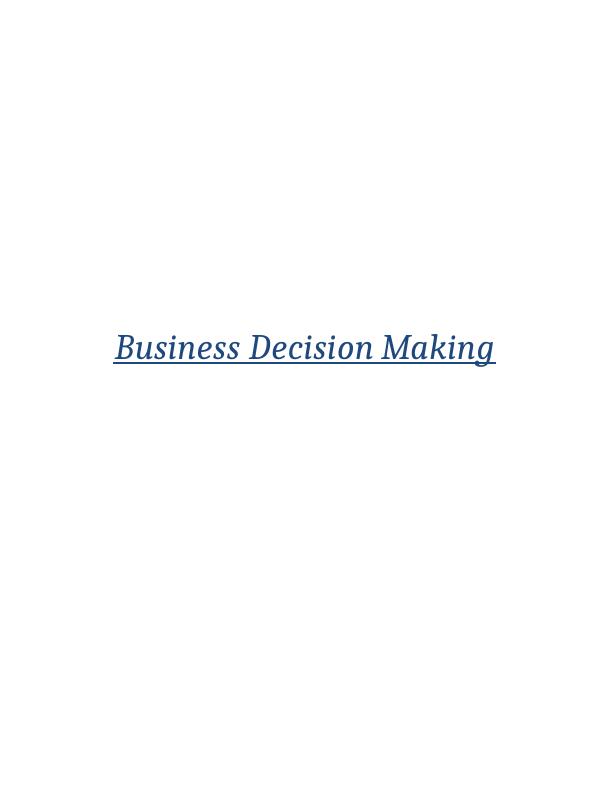
Table of ContentsINTRODUCTION................................................................................................................................1TASK 1.................................................................................................................................................1Q.1 Collection of primary or secondary data and discussion on survey methodology andsampling technique......................................................................................................................1Q.2 Market survey questionnaire.................................................................................................2M1 Ways of calculating coefficient of skewness and its use in improving organization'sperformance.................................................................................................................................5TASK 2.................................................................................................................................................5TASK 2.................................................................................................................................................5Q.1 Mean and Mode and Median................................................................................................5Q.2 Range and Standard Deviation..............................................................................................7Q.3 25th Percentile (Lower iii. 25th Percentile (Lower Quartile) and 75th Percentile (UpperQuartile) and use of Percentile.....................................................................................................9TASK 3...............................................................................................................................................11Q.1 Producing column and bar graph for sales cost and profit..................................................11Q.2 Line graphs showing trend lines which can be used for projecting sales and profit..........13Q.3 This part is covered in PowerPoint presentation.................................................................15D1 Evaluating use of time series analysis as a tool for forecasting...........................................15TASK 4...............................................................................................................................................16Q1 Gantt chart............................................................................................................................16Q2 Network Diagram.................................................................................................................18Q.3 Use of financial tools for decision making.........................................................................19D3...............................................................................................................................................23CONCLUSION..................................................................................................................................24References..........................................................................................................................................25
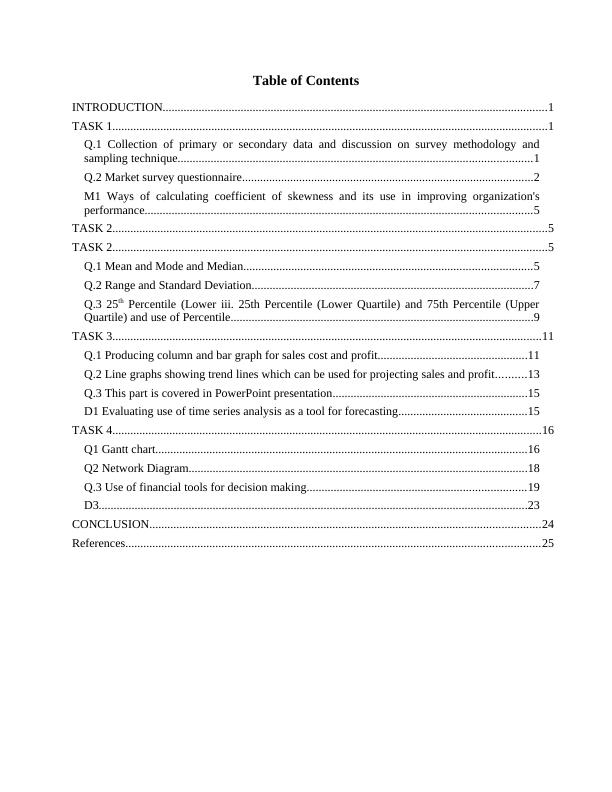
INTRODUCTIONBusiness decision making is regarded as an essential part of every business. This is beingcarried out with an aim to make selection of suitable course of actions that can result inattainment of success by the firm. It is regarded as a cognitive process that leads to the selectionof appropriate action among the various alternatives present (Black, 2011). For the purpose ofsurviving for the longer term, it is essential for the corporation to take into account differentactions so that it can achieve desired targets in an appropriate manner. In the present report, business decision making has been discussed with respect toSyngenta. The firm is one of the world's leading companies that possesses more than 28000employees in approximately 90 countries. Main purpose of the business to bring plant potentialto life. The company is planning to launch new product that is Amistar which is a broadspectrum fungicide that can be used in Integrated Pest Management. The country chosen for thelaunch of Amistar is London. The present study entails to make the use of wide range of sourcesfor data collection. Further, it covers understanding regarding range of techniques for theanalysis of data. The report involves the production of information in a suitable formation fordecision making. Lastly, the study makes use of software generated information to developdecisions at operational, tactical and strategic level within business. TASK 1Q.1 Collection of primary or secondary data and discussion on survey methodology andsampling techniqueThe launch of Amistar will be done in the country that is London. This is used in order toreduce the threat of diseases that might occur from various pests such as cockroaches, beds,bugs, mice, rats as well as moths etc. Launch of Amistar can be beneficial for London as itmakes country clean and free from pests (Fassin, Van Rossemand Buelens, 2011). The techniqueof data collection is regarded as the most crucial business activity that acts as an aid in takingsuitable decisions. Further, it is essential for the purpose of gathering information with an aim togain knowledge regarding preferences as well as opinions of respondents in an effective manner.In the present study, data has been gathered in order to take appropriate decision related tolaunch of Amistar in London. With an aim to know whether or not the particular decision wouldbe profitable for Syngenta, collection through primary and secondary sources has been used.Through this, better understanding can be developed with respect to values and beliefs of1

consumers regarding the launch of Amistar in London (Alexander, 2007). Market research isconsidered as an effective source that assists business in gaining insight to the opinions ofexisting customers with respect to particular plan. Data collection sources such as primary andsecondary have been enumerated in the manner below:Primary data: Under this, information is gathered by the direct interaction withrespondents. The technique of survey has been incorporated in order to gatherinformation from the existing customers in an effective way (Goetsch and Davis, 2014).Questionnaire has been developed by the researcher in order to gain knowledge regardingagreement or disagreement of the respondents with respect to launch of Amistar inLondon. Secondary data: In this, data is collected through past financial information of theorganization. This includes sales records, profitability data as well as annual reports. Thisis effective in offering clear picture of the capability of Syngenta in order to launchAmistar in London. It takes less time and minimal efforts for the purpose of gatheringinformation through secondary sources (Aharoni, Tihanyiand Connelly, 2011). But, it isnot obvious that data offers accurate information with respect to the preferences ofexisting customers towards the project plan. In the present study, for the purpose of data collection, the technique of survey is beingused. Under this, viewpoints of the customers can be gathered through the technique ofquestionnaire. This is comprised of open ended and close ended questions. Open ended questionacts as an aid for Syngenta in gaining insight to the opinions, views as well as attitude of thecustomers in relation to the launch of Amistar in London project plan (Kownatzki and et. al,2013). In contrast to this, close ended question restricts the choice of respondents as suchquestions possess multiple choices. Therefore, existing customers are conjugate to present theirviewpoints from the choice offered. The technique of sampling that is being used in the presentstudy is probability sampling. Under this, selection of sample is done on the random basis. Thisis because it offers equal opportunity to every individual in getting selected as sample for thepurpose of investigation. The size of sample would be 20 which includes existing customers ofSyngenta. Sampling frame is regarded as small unit of population that represents the entirepopulation (Madsen, 2007). 2
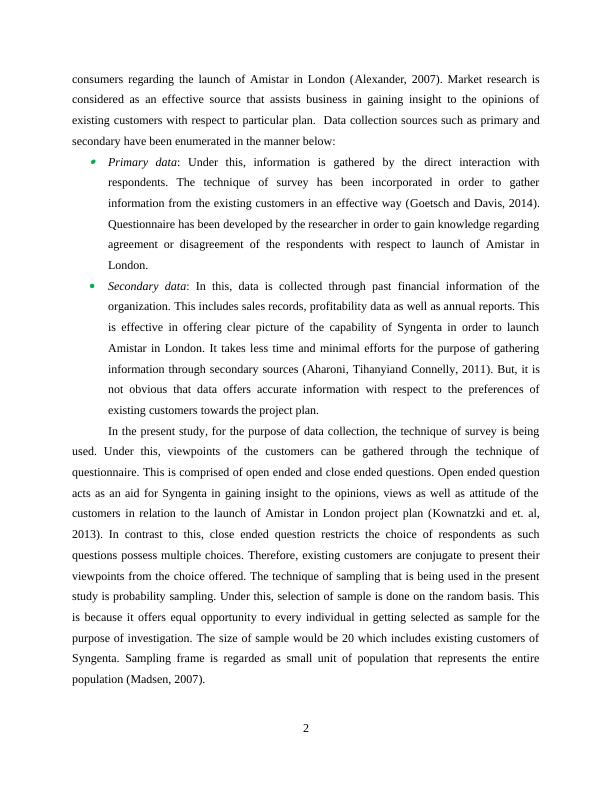
Q.2 Market survey questionnaireQUESTIONNAIRE(Kindly take few minutes to provide your responses. Your feedback is appreciated)Demographic informationName:Age:Gender:Male □Female □ 1. From how long you have been using products and services of Syngenta?Less than 5 year □ 5-10 years □ Above 10 years □ 2. Do you make purchase of products and services offered by Syngenta?Yes □ No □ 3. What are the factors that attract you towards purchasing of Syngenta's products? High quality □ Reasonable prices □ Attractive discounts □ Benefit of location □ 4. Are you satisfied with the services provided by Syngenta?Strongly satisfied□ Satisfied□ Neutral□ Dissatisfied□ Strongly dissatisfied□ 5. Do you agree with the statement that Amistar can offer better prevention from cockroaches,beds, bugs, mice, rats as well as moths etc.?Strongly agree □ Agree □ 3
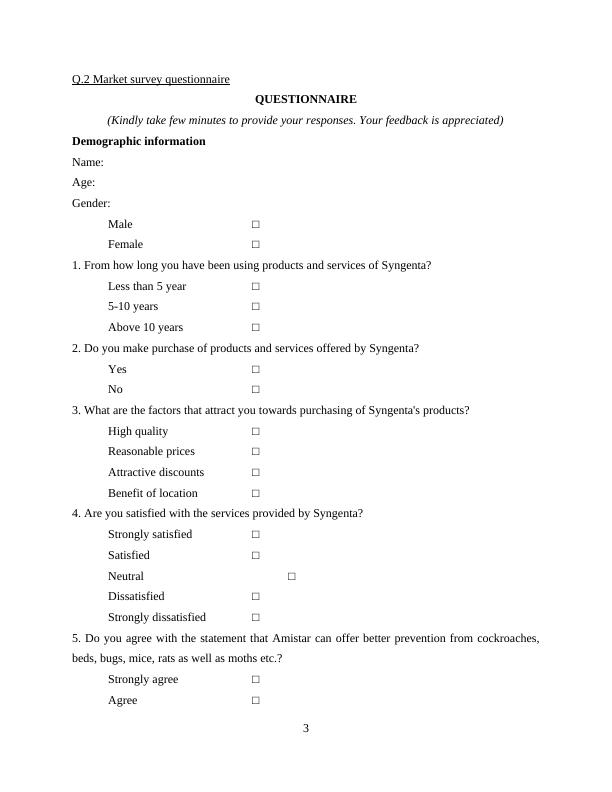
Neutral□ Disagree □ Strongly disagree □ 6. Do you agree with the view that launch of Amistar can be beneficial for London?Strongly agree □ Agree □ Neutral□ Disagree □ Strongly disagree □ 7. Do you think, Amistar can enhance global food security? Yes □ No □ 8. What is your level of agreement to the view that Amistar can lead to responsible agriculture inthe London? Strongly agree □ Agree □ Neutral□ Disagree □ Strongly disagree □ 9. Are you satisfied with the pricing policy of Syngenta in terms of affordability?Strongly satisfied□ Satisfied□ Neutral□ Dissatisfied□ Strongly dissatisfied□ 10. Do you agree with the view that integrated pest management can be effectively carried outthrough Amistar?Strongly agree □ Agree □ Neutral□ Disagree □ 4
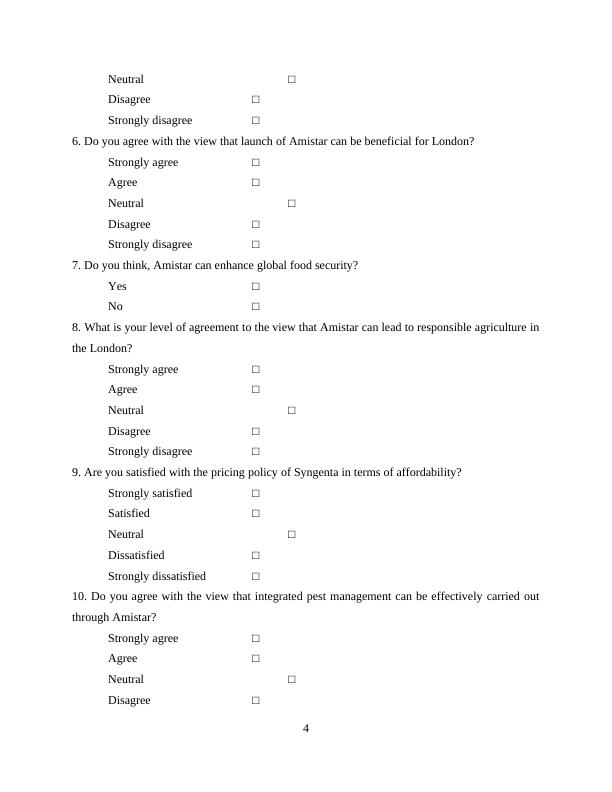
End of preview
Want to access all the pages? Upload your documents or become a member.
Related Documents
Process of Business Decision Makinglg...
|20
|5243
|143
TASK Market survey questionnaire 5 M1 Ways of calculating coefficient of skewness 6 Q1 Mean, Mode and Median 6 Q2 Range and standard deviation 8 Q3 Coefficient of skewness 6 Q1 Average, Mode and Medialg...
|22
|4554
|243
Business Decision Making (BDM) - PDFlg...
|18
|4610
|187
Case Study on Business Decision-making- Syngentalg...
|23
|7013
|61
Business Decision Making in Syngenta- Reportlg...
|17
|3479
|48
Business Development Management Case of Syngenta - Reportlg...
|21
|4867
|83
